Email makes the world go around, right? No matter how many times you read about “the death of email”, it remains paramount in the online world. In fact, I’ll bet you’ll receive at least two emails in the time it will take you to read this article from start to finish.
Are all emails created equal? No, not exactly.
According to Salesforce, the top 3 uses of email are newsletters (66%), promotional content (54%) and welcome series emails (42%). However, the top 3 most effective emails are mobile opt-ins (76%), birthday emails (75%), and transactional emails (74%).
Promotional emails get a bad rap, but when they work, they really work. SocialMedia Today, 43% of recipients made at least one purchase last year based on a promotional email.
The 4 Main Types of Promotional Emails
Of course, there are many types of promotional emails. The only limit is your creativity. However, there are four types of promotional emails you see quite often: sales / special offer emails, upgrade emails, event / invitation emails, and blog emails.
1. Sales, Special Offer & Holiday Emails
These are the emails you probably think of first when you think “promotional emails”. They’re the “50% off everything for 24 hours emails”, the “get your mom a nice sweater for Christmas” emails, the “it’s June 2nd at 1:15 p.m., so here’s $10 off your next purchase” emails.
These can get tired, so here are a couple suggestions for improving them…
- Remind recipients of what they love. What’s the last thing they purchased? If it has an expiry date, let them know that item is back in stock. If it doesn’t, make recommendations based on that product. What would complement it? What have other customers bought with that product?
- Find out what holidays (e.g. Valentine’s Day, Earth Day, Hug Your Cat Day), events (e.g. March Madness, The Golden Globes) and seasonal changes your recipients care about. Use them as a reason to reach out, giving your email context. Conduct some audience research so your emails stand out and feel personal. Anyone can send a Boxing Day promotional email.
Example: Good Fucking Design Advice
Notice how simple and on brand this promotional email is…
2. Upgrade Emails
You’ve been using a free (or cheaper) version of their product or service for a few months now. Then, it arrives. It’s your invitation to upgrade to a paid (or more expensive) version. SaaS companies, I’m looking at you this time.
Example: Hello Bar
Hello Bar disguises their upgrade email as a helpful performance update. This combats the negative image upgrade emails currently have.
3. Event and Invitation Emails
Most people like to be invited to things. It makes us feel connected and liked. Even though you never go to your office Christmas party, you like to at least be invited. Well, that’s why event and invitation emails can be so effective. Think of conference announcements, early access invitations, membership invitations, etc. for this one.
Example: Nextdoor
Nextdoor invites you to early access to the Holiday Cheer Map, underscoring that it’s an exclusive invite with “All Nextdoor Sullivan neighbors will have access to the map soon […]”.
4. Blog Emails
Blog emails are fairly common. You likely subscribe to at least one or two blogs. As a result, you get an email every week with a list of new content or even every time a new post goes live.
Whatever you do, please avoid clickbait titles. Clickbait is just another word for disappointment. Think about it. Your recipients open your email expecting something “they won’t believe in a million years” and end up with another list of the best content marketing tactics. Disappointment.
Example: CXL
At CXL, we notify subscribers of new blog content via our weekly newsletter, which might also include news in the intro (e.g. CXL Live tickets are on sale, our annual Reader’s Survey is live, etc.)

Where Promotional Emails Go Wrong
Again, this list is only limited by your creativity. The number of mistakes people make with promotional emails goes on and on. However, there are three major offenders: a lack of segmentation, inconsistency, and a lack of context.
1. Lack of Segmentation
Although segmentation is something companies know they should be doing, Chris Hexton of Vero points out that few companies do it well…

Chris Hexton, Vero:
“Batch and blast is something all companies know they should do but few really get into and conquer it. All companies are learning and the tools to help you capture more data to do segmentation are improving.”
You know a lot about the people on your email list. You can segment them by…
- Age, gender, persona, etc.
- Country, state / province, zip code, etc.
- Job title, company, industry, email type, etc.
- Date added, signup location, etc.
- Open rate, click rate, etc.
- Average order size, date of last purchase, frequency of purchases, past purchases, shopping cart abandonment, etc.
- In-store buyers, online buyers, buyers who have referred a friend, etc.
Segmentation is fairly standard for all email marketing platforms. It’s built right in, so there’s no excuse for not segmenting your lists. According to MailChimp, on average, segmenting means open rates will be 14.28% higher and click rates will be 57.69% higher.
Wrong: Macy’s
Take a look at this Macy’s email promoting a Father’s Day sale…
Really? Some of his top faves are “Women” and “Handbags”? I have no way of knowing who received this email, but it screams “uncustomized email”.
Right: MailChimp
Now check out this MailChimp email…
Again, I have no way of knowing who this email was sent to. However, it seems like an upgrade email customized for customers on the “Growing Business” plan.
2. Inconsistency
Chris adds that inconsistency is clutch, yet often overlooked…

Chris Hexton, Vero:
“I’d also say that most people treat promotional email as very separate from their other emails and this is dangerous: it should be seen as integral to the brand and product experience. Remember this and remember to consider promotional email as part of the customers’ journey with your business. Don’t cheapen what you’re doing.”
Promotional emails are, unfortunately, often treated as a money grab. In other words, marketers stuff as many promotions as they can into one email and hope something sticks. Or they separate the promotions and end up sending far too many emails. Either way, it’s tarnishing the brand experience.
Wrong: Grammarly
Take a look at this email from Grammarly…
Can you spot the problem? Likely, an email was sent prior to this one, promoting a limited time only promotion. Now the email has been extended by another 24 hours…? There goes the exclusivity. How do you think that makes the people who purchased the first time feel?
Scarcity works well unless it’s fake.
Right: Cards Against Humanity
Are you familiar with Cards Against Humanity? Check out this Black Friday email…
If you’re familiar with Cards Against Humanity, you know that this email is incredibly consistent with their brand. It’s a positive addition to their brand experience.
3. Context Is MIA
According to Convince and Convert, 80% of social network members have received unsolicited email or invites. Jimmy Daly explains why that’s a problem…

Jimmy Daly, Vero:
“Context rules above all else in the email world. The more expected the message, the more likely you are to convert. So let’s start with the premise. Why am I receiving this email?” (via Vero)
Before you send an email, ask yourself whether recipients will understand why they’re receiving your email. Yes, it’s Christmas, but didn’t you just send a promotional holiday email last week? Are you about to send people who never use your product an upgrade email?
Wrong: West Elm
Here’s a West Elm email…
Why am I receiving these top 10 essentials? Essentials for what, exactly? Why are you telling me about a discount on bedroom furniture when there’s none promoted in this email?
Right: charity: water
Now check out this email from charity: water…
Giving Tuesday is the same day as Black Friday. It’s designed to downplay commercialism and start the holiday season off with giving vs. buying. I’m receiving this email because I support charity: water, which indicates giving is important to me. Context!
Step 1: Deliverability
When to Send Your Email
One of the most common questions people have about email deliverability is, “When should I send my email?” John Foreman, Chief Data Scientist at MailChimp, has the honest answer…

John Foreman, MailChimp:
- “Send midmorning during the work week…
- …unless you know something about your audience, which you really should. In which case, the previous point is probably wrong.
- Use STO or A/B testing to get a better answer.” (via MailChimp)
How Spam Filters Come Into Play
Another common question is about spam filters. “How can I avoid spam filters to ensure my email actually makes it to inboxes?”
First, you have to understand how spam filters work. Filters use a long list of criteria to give each email a score. If the score is too high, it’s marked as spam. What’s considered a passing score on one server might not be considered a passing score on another server.
Also, it’s worth noting that the list of criteria and the weight of each item on the list is always changing. For example, SpamAssassin is one of the most common open-source spam filters available right now. They don’t publish their list of rules and their corresponding weights because the tests are published nightly. The filters are constantly learning, evolving.
However, there are some general rules you can follow…
- Don’t email old or inactive lists (unless you clean them up). People change emails over time, people won’t remember you if you haven’t emailed in a month or two, and sometimes people just lose interest. The result? Spam filters (and real people, too) will think you’re sending spam.
- Don’t send emails with a large image and little to no text. Spam filters don’t read images, so they’ll assume your email is spam.
- Check your HTML carefully before you send. Be careful copying content from Word or Pages to your email marketing platform. The formatting won’t transfer well and spam filters will think your email is spam.
- Avoid using caps, excessive exclamation points and cliche sales phrases. This one is just obvious. Both are traditional indications of spam, so filters are quick to capture it. This is especially true for subject lines, preview copy and introductions.
How to Deal With Human Spam Filters
Even if you make it by the filters, you need to worry about your recipients mistaking your email for spam. According to Convince and Convert, 43% of email recipients mark an email as spam based on the email “from” name or email address alone. Worse? 69% mark an email as spam based solely on the subject line.
So, most people make spam decisions before even opening the email. Be extra careful how your email will appear in a preview pane (more on that in a bit).
Here’s how to avoid that…
- Never buy (or even accept) an email list. If you send a promotion email to list of people who have never heard of you, you’re shooting yourself in the foot. You’re going to be reported as spam (or even abuse) multiple times. The result? The deliverability of future campaigns will suffer.
- Make opting out easy. Seriously! Don’t make opting out difficult. No, you don’t want to lose emails, but you also don’t want someone who doesn’t want your emails bringing down your engagement numbers, which affect spam scores. Plus, you can be reported for abuse if opting out is extraordinarily difficult.
- Don’t lie about email content / frequency. Remember when we talked about clickbait? Lying about how often you’ll reach out to someone (and for what reasons) is the equivalent of clickbait. You’re not setting expectations, so you’re setting yourself up to disappoint. Just because someone subscribes to your blog, doesn’t mean you can send them dozens of promotional emails, too.
Step 2: Preview
According to Convince and Convert, 84% of people 18-34 use an email preview pane. That means recipients are judging your email before they even open it. Your preview pane is your first impression, so you should put some serious effort into optimizing it.
How to Choose a “From” Name
First, we have the “from” name. Your options here are rather limited…
- Company name.
- Your first and last name.
- Your first name and company name (e.g. “Shanelle from CXL”).
So, how do you decide? Here’s what Colin Nederkoorn from Customer.io had to say about the “from” name…

Colin Nederkoorn, Customer.io:
“The strategy that we use and the one that I personally like is your first name from some company name. […] I’d say the downside with that if you’re the sole business owner and you’re trying to build a strong personal relationship with someone, having the company name in there still, in the back of their mind they’re like, ‘This is some business email.’
So sticking to the personal stuff if it’s just you and you’re really trying to establish a personal relationship, I think that’s good, but otherwise if they’re really signing up with a company, not with you, then have the company name (e.g. Colin from Customer.io or John from Drop Dead Copy).” (via McMethod)
Here’s that list again…
- Company name. -> Best for large companies.
- Your first and last name. -> Best for solopreneurs trying to establish a 1-on-1 relationship.
- Your first name and company name (e.g. “Shanelle from CXL”). -> Best for small companies trying to establish a 1-on-1 relationship.
Ultimately, these are just guidelines and you should choose the one that feels right for your brand.
How to Perfect Your Subject Line
Next up, we have the subject line. This could, of course, be an entire article in itself. After all, subject lines are really just titles. The same rules, more or less, apply. So…
- Make it clear, but leave a little mystery. You want to be very clear and specific in your subject line, leaving only a hint of mystery. Your subject line should give people an accurate expectation for the email’s content. If the expectation is off, the subject line is off and conversions will suffer.
- Keep it simple, keep it brief. For the most part, you want your subject line to be fewer than 50 characters. Otherwise, you run the risk of being cut off. The need to be brief, fortunately, makes it more likely that you’ll keep it simple. Remember, you’re dealing with a generation of scanners, so long and complex subject lines aren’t the smartest choice. (Especially since everyone’s aiming for Inbox 0.)
- Fulfill a desire or squash a pain point. Please avoid spammy and promotional lingo at all costs. It sends a red flag up the pole, alerting recipients that your email is self-serving. Instead, focus on offering something your recipients want (e.g. a more modern living space and more digestible analytics) that you have or something you have that will eliminate a popular pain point (e.g. boring, outdated furniture and clunky, incomprehensible sets of data).
- Format correctly. Make sure the first letter of every new word is capitalized. Avoid using periods (and other “stoppers”). As of 2014, the average number of daily business-related emails sent and received per person is 121. By 2018, it’ll be 140. If you don’t optimize your formatting, you won’t stand out.
If you need some inspiration, I highly recommend reading Joanna Wiebe’s The Ultimate Guide to No-Pain Copywriting (or, Every Copywriting Formula Ever). Take the 10-15 minutes to check it out (I promise it’s worth it).
How to Write Preview Copy
Finally, there’s your preview copy. This is the few lines you’re given to elaborate on the subject line and hook recipients in. Think of it as your sub-headline, to some extent.
It’s displayed differently, depending on the email client. Heck, some email clients don’t support it at all. Some allow one sentence, others two, others three, etc.
What’s important is that it…
- Connects to your subject line.
- Provides context for the email.
- Doesn’t “give it all away”; there’s still some mystery.
Also, note that this is a good place to create urgency. It’s less direct and promotional than placing it in the actual subject line.
Step 3: Inside Copy / Design
You already know how important context is. Answer that big question (“Why am I receiving this email?”) as quickly as you can once the email has been opened.
The Importance of Browser and Device Testing
So, we can move right on to browser and device testing. Before you send your email, it’s absolutely critical that you check on how it appears in all browsers and on all devices. Thanks to cognitive biases, it’s easy to think everyone uses Gmail just because you do. Or an iPhone. Or a Mac.
Litmus released this list to help guide you…
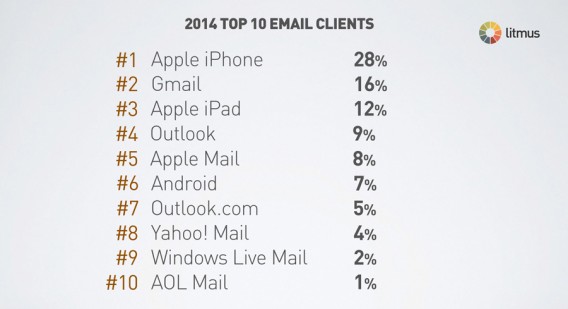
They also demonstrate how frequently various mobile device owners open emails…
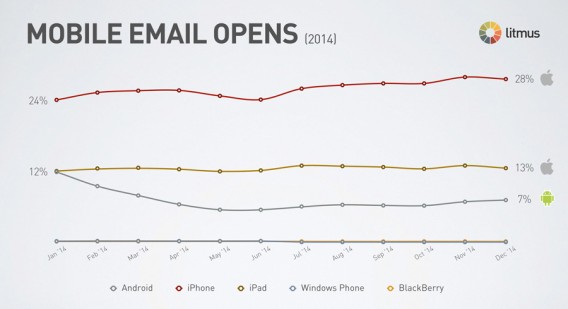
And even how mobile stacks up against desktop and webmail use…
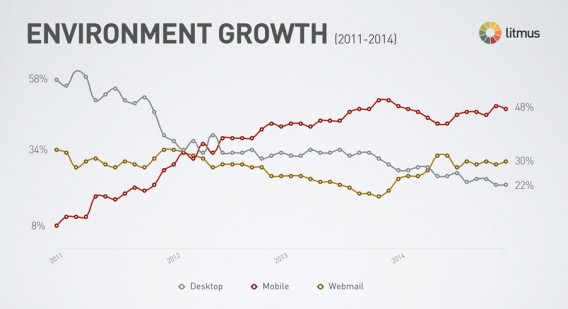
Of course, these numbers could be very different for your unique audience, which is what really matters. Within your email marketing platform, you have access to this kind of information. What percent of your recipients open your emails on mobile? Which devices are they using most often? What browsers?
Once you know how your audience likes to read your emails, you can (a) conduct more informed browser / device testing and (b) begin optimizing for those devices, browsers, etc. For example, perhaps you’ve been sending emails with small buttons to a largely mobile readership. Big mistake, right? Now you know.
One final note: You should check your email on all devices and browsers, not just the ones you identified.
Why?
If 125 people on your list use Outlook.com and your email looks awful in that email client (e.g. images not loading, formatting is off, etc.), you know those people won’t convert. That’s 125 wasted emails, 125 wasted opportunities just because you didn’t conduct quality assurance.
How Valuable Is Your Email?
Once you’re sure your email looks good no matter what device / browser it’s viewed on, move on to your value proposition and benefits. Now, crafting a value proposition for your email is the same as crafting a value proposition for your site: You want to make the value of the email as clear as possible as quickly as possible.
So, instead of reiterating what has already been said, I’ll recommend you read Peep’s Useful Value Proposition Examples (and How to Create a Good One).
Spend time on this and ask yourself these questions…
- Is this email going to provide value to this list?
- What is that value?
- What is that value worth to me?
- Is this email providing an equal or greater value?
If the answer to that last question is no (i.e. 5% off if you purchase $300 or free shipping over $200), go back to the drawing board. Emails need to be valuable (duh) if you want to (a) get attention in busy inboxes, (b) maintain a good relationship / image, and (c) convert your recipients.
How Visual Hierarchy Comes Into Play
Some of you will choose to send emails that are largely text-based, despite how that might impact spam scores. If you do, be very aware of visual hierarchy, the arrangement of elements in a way that implies importance. It’s easy to design an email in a way that divides attention too much or focuses readers on the wrong part of the email.
What catches your eye the most when you look at your email? Ask a friend or colleague the same question. Are the right elements at the top of your hierarchy? Where does your call to action (more on that soon) fall in the hierarchy? Your value proposition?
Make sure…
- The most important elements (i.e. call to action and value proposition) are high on the visual hierarchy.
- The eye flow from the top of your email to the bottom is obvious, systematic and simple.
- You don’t have too many elements competing for attention all at once. Be patient.
You see visual hierarchy mistakes all the time in promotional emails. “THIS CAR IS ON SALE. AND SO IS THIS JET SKI. AND SO IS THIS FOUR WHEELER. DON’T FORGET THIS SNOWMOBILE.” Be careful. These mistakes are what give promotional emails a bad name.
Tip: Always include a plain text version of your email. First of all, some people just prefer it. Others use email clients don’t support HTML emails (yes, really). Finally, spam filters like to see a plain text version included as well.
What Language to Use in Your Emails
The last major tip here is about the language you use when crafting your email. The two most important factors are: active language and pronouns.
Active language means the subject of the sentence performed the action. The alternative is passive language, which the subject of the sentenced received the action of the sentence. Let look at an example…
- Passive: The report was completed last Friday by Tom.
- Active: Tom completed the report last Friday.
It’s a subtle difference, but it makes for more engaging copy.
When it comes to pronouns, you want to focus on “you”. Why? It inserts the reader into your copy. They subconsciously feel as though you’re writing only to them, 1-on-1. If you take a look back through my recent articles, you’ll see that I use “you” often.
Step 4: Call to Action
Clarity Is Still King
It’s incredibly important to have a clear call to action. You’re familiar with the expression “one page, one goal”, right? Well, the same applies to email. One email, one goal.
Yes, you want your recipients to check you out on social media and maybe also look at your clearance items and maybe also review a product, but what do you want most? You want them to take advantage of the promotion.
Make sure that’s obvious and that other calls to action are more muted, not competing for attention / clicks.
Be Patient With Your CTA
One of the most common promotional email mistakes is rushing the call to action. Colin explains…

Colin Nederkoorn, Customer.io:
“I think the other thing, the other mistake people make is they put the action as the first thing in the email. Then they try to put all of the reasons why underneath, and I think if you know the AIDA structure; action–attention, interest, desire action, you don’t want to put the action before you’ve built up the desire to take it.
So giving them all of the reasons why they want to do that thing before you ask them to do it generally yields better success. But I think it stems from people thinking about it’s got to be above the fold, I think that’s why people put it as the first thing in the first link or the first button or whatever in the email. But a lot of times I’ll see emails that have 10 things they want you to do and it’s all above the fold, and I suggest to people that they don’t do that.” (via McMethod)
Where should you put the call to action? The most honest answer is that you should put it where it makes the most sense and then test that positioning. Sure, a handful of people might see your brand name, open your 20% off sale email and click the call to action right away. Most people won’t, though.
Does that mean your call to action has to be at the end? No, of course not. It means you should place the call to action wherever recipients might be tempted to convert.
You’re basing this on instinct, so be sure to test it. Maybe recipients aren’t as motivated as you think they are until they’re 3/4 finished the email. Maybe they’re super motivated, hunting for sales, and want to convert right after the value proposition.
How Image Blocking Works (and How to Deal)
Are you familiar with the concept of image blocking? Justin Jordan of Litmus explained it (and offered solutions) in the 2X Your Conversion Rate in Less Than 30 Days email course…

Justine Jordan, Litmus:
“While images will be displayed in many desktop, mobile, and webmail inboxes, in some they will be disabled. If you want your subscribers to convert, you must make your email legible—and actionable—regardless of whether images are present or not.
Luckily, there are a number of strategies to help combat image blocking:
- Include alternative text (ALT text): When images are disabled, ALT text renders in place of the image. Use ALT text to provide some context for subscribers when images are disabled.
- Use bulletproof buttons: CTAs should be viewable—and actionable—regardless of whether images are present or not. Add a little HTML and inline styles and rest-assured that your CTA buttons will display even when images are blocked.
- Balance imagery and text: Use a balance of live text and imagery to ensure your email is legible and easy to interact with regardless of whether images are present or not.”
If marketers optimized their emails for image blocking, ROI would increase 9+% on average, according to Convince and Convert. Don’t overlook this step.
Do Text-Based Calls to Action Work?
Here’s a question I personally am asked quite often: Are text-based calls to action still effective? As long as that text stands out (e.g. it’s in a contrasting color, it’s not hidden in a huge block of text, etc.), they are still effective. As with all things conversion rate optimization, the only way to determine if they’ll work better for you and your audience than button calls to action is to… test it.
How to A/B Test Your Promotional Emails
If you’ve followed all of these steps, you should have a pretty solid email. Of course, it could always be better. That’s why it’s important to A/B test.
In fact, MailChimp shared this chart in 2014 to demonstrate the power of email experimentation…
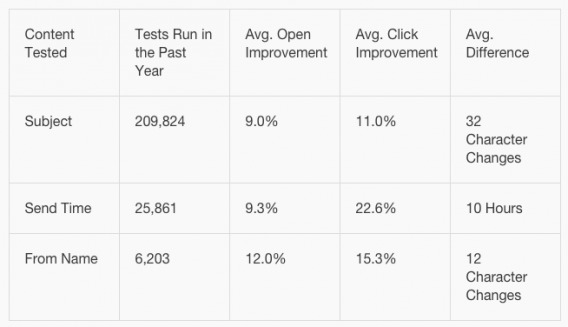
Most email marketing platforms have A/B testing built right in. When creating a new campaign in your preferred platform (e.g. Vero, MailChimp, GetResponse, MailJet, Customer.io), look for the option to A/B test. Half of your audience will receive the control and the other half will receive the variation.
Be careful about running more than one test at a time. Often, they will conflict with one another, distorting your data.
You can follow this step-by-step process and expert advice, but nothing compares to data from your actual audience.
Allison Sparrow from Optimizely has a critical piece of advice for email experiments…

Allison Sparrow, Optimizely:
“A successful email experiment not only allows you to make a decision at that point in time, but it also provides you with a new piece of knowledge that you can apply in future email sends. If the winning variation only applies to the test you just completed, you are missing out on an opportunity to get the most value out from your experiments.
I realized this while pulling the results of a particular test where the variation (FAQ: How long should my test run?) saw a 33.9% increase in clicks.
Subject line test
Control: Are you measuring your tests accurately? Measuring statistical significance of your test
Variation: FAQ: How long should my test run?
Stoked on this result, I went to post the findings in Optiverse, only to realize that I didn’t actually know what had made the variation successful. Did people click on this variation because they liked to read FAQs? Or because it was written in first person? Or something else entirely?” (via Optimizely)
While everything is testable, here are some high value areas to focus on…
- From name.
- Subject line.
- Preview copy.
- Headlines / Subheadings.
- Copy type (image-heavy, text-heavy, newsletter style, letter style, etc.)
- Copy length.
- Promotion type (% off vs. $ off, for example).
- Send time / day of the week.
- Buttons / Image CTAs vs. text CTAs.
- Link and CTA density.
- Audience. (Is the email going out to the most relevant segment?)
So, what’s a good open rate? A good click rate? Well, here’s a look at the average numbers (according to MailChimp), based on company size…

But the truth is that a good open / click rate is a better open / click rate than you have right now. A “good ____ rate” is a better ____ rate than you had last month.
I’d be remiss not to mention how important metrics are. It’s very easy to measure open / click rates and declare a winner. In fact, according to Salesforce, 47% measure the success of their email marketing campaigns based on their click rates.
However, you should always be measuring as close to the money as possible.
A clickbait email could result in crazy high open / click rates, but next to no revenue. Similarly, a regular old email could result in low open / click rates, but translate to serious cash in the bank. Be careful which variation you declare a winner.
Case Study: Optimizely’s Call to Action Experiment
Above, Allison talks about the importance of using your experiment data to extract insights and spot trends that can be used to improve future campaigns. Here’s an excellent example that she shared in the same article…

So, we have different button copy: Watch Webinar vs. View Presentations & Slides. The latter won, which led Allison and the Optimizely team to realize something quite valuable.
“Our customers like checking out slides, not just video. We were also able to prove ROE for uploading our webinar slides to Slideshare,” she wrote. They were able to apply that learning to future emails!
Conclusion
Promotional emails don’t have to be spammy, annoying and quickly deleted. They can be genuinely valuable and profitable if you’re willing to put in the work. [Tweet It!]
Start by avoiding these three major mistakes…
- Segment your emails to utilize more targeted promotions.
- Make your promotional emails consistent with the rest of your brand experience.
- Ensure recipients know why they’re receiving the promotion.
Then, work your way through the step-by-step guide above and start testing. No one can tell you how to craft the perfect promotional email for your audience, but these guidelines and the experts included in this article can definitely set you on the right path.
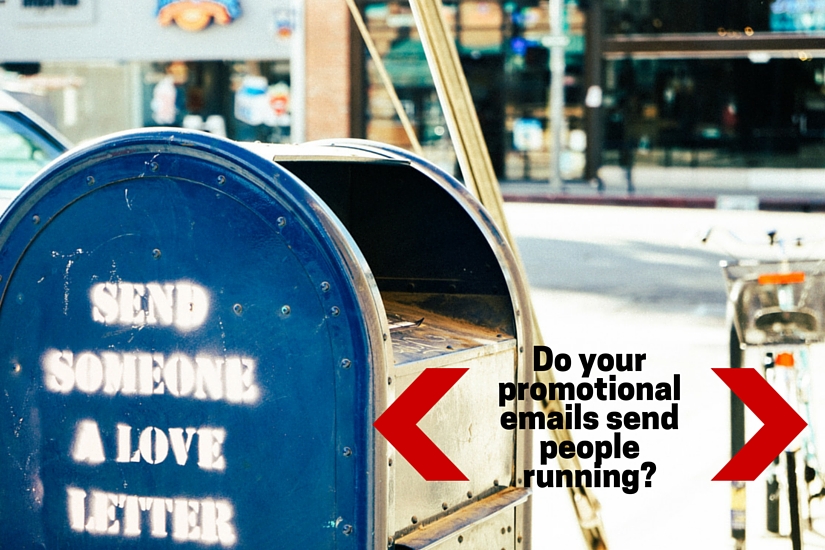
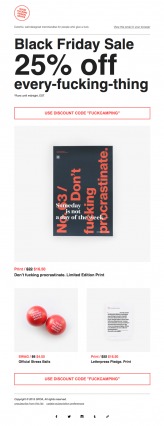
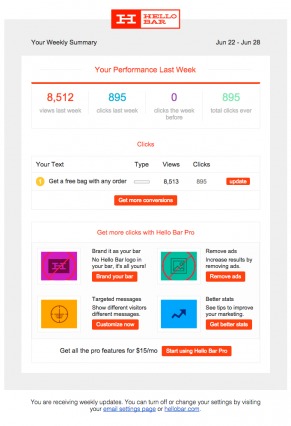
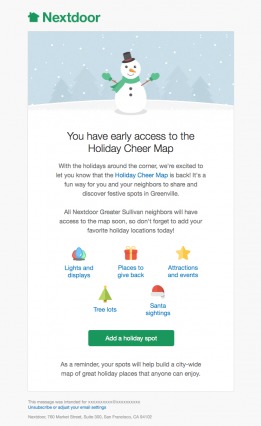
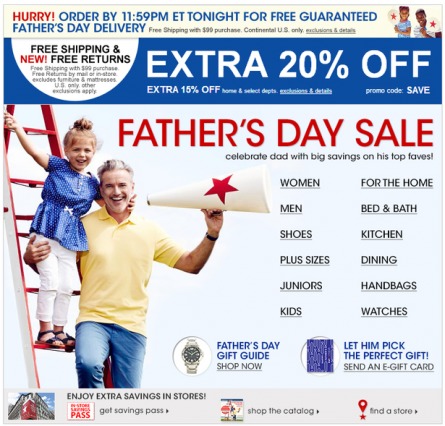
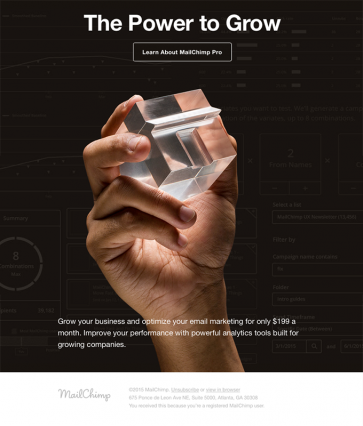
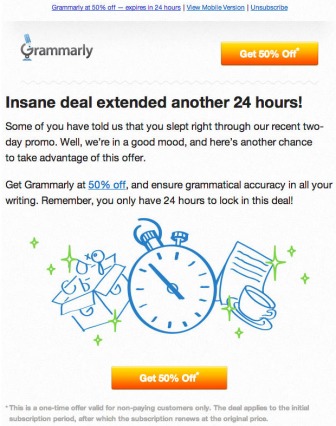
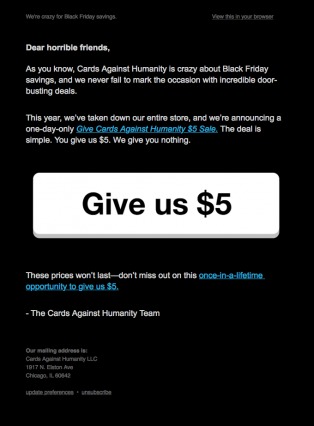






WOW … super thorough.
And stellar job in the conclusion brining ALL these examples, data points, and 5,000+ words together, esp. the “why” issue.
I’m definitely gonna refer to this … again and again.
Thanks so much, Aaron! I really appreciate it.
Agreed with Aaron. This is wonderful.
Already forwarded to our email coordinator.
Thanks!
Awesome! I hope it helps. Let me know if either of you have any questions / interesting thoughts about this.
Quite honestly this was the most productive insightful comprehensive email I have ever read in bed on s Sunday morning at 9am!! And that in itself is indicative of one of the many user experiences that we overlook. A lot of receipients can be in different time zones .. I find 90% of marketers ignore this .. so being in Australia all those emails are competing for my attention at exactly the same time when I wake up mostly .. or the next hour or two.
So many things to think about but this post is awesome thank you!! Best email post in 2015.
Wow! Thanks Paul. Glad you liked it. Thanks for reading CXL. :)
Love the incredibly thorough guide.
But this would all be for nothing if not for segmentation. I don’t think it’s stressed nearly enough that an email needs to be relevant to me, otherwise it goes straight to the spam bin. At that point, you very well might lose credibility for future emails as well.
Couldn’t agree more, Alex.
I think email segmentation could be an entire article on its own.
Wow Shanelle! This is an amazing guide. I’ve shared everywhere!
I see time and time again people sending affiliate offers that don’t stuck a cord with their audience. If you’re being promotional, that’s fine. But you can be promotional AND helpful, like this article. Sort of a consultant position, instead of a marketer one :)
Thanks for sharing again!
Nice! Thanks Hernan. I really appreciate it.
I like the consultant reference. That’s a good way to put it.